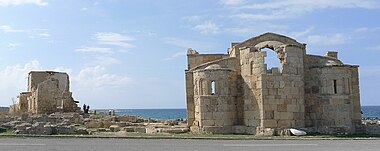
Karpasia (Ancient Greek: Καρπάσεια and Καρπασία), Latinized as Carpasia, and also known as Karpasion (sometimes mistaken for Karpathos), was an ancient town in Cyprus, situated in the northern shore of the Karpas Peninsula, at a distance of 3 km from the modern town of Rizokarpaso. According to tradition, it was founded by the Phoenician king Pygmalion of Tyre. It had a harbour, whose moles remain visible to this day.
According to archaeological evidence, the earliest possible date for the foundation of the town is the 7th century BC. It was first mentioned in literature in 399 BC. The town was mentioned by the writers of antiquity, including Strabo. The city is also mentioned in the Hellenica Oxyrhynchia, which is papyrus fragments in Greek with the history of ancient Greece. In 306 BC, the town was the site of landing for Demetrius I of Macedon, whose forces stormed Carpasia and the neighbouring town of Urania, before proceeding to Salamis.
The architectural style as well as the techniques used in building the stone houses of the town incorporated elements of Phoenician influence.
In the Delphic Theorodochoi inscription (230 BC), which was published by André Plassart, there is a mention of a Karpasian man who was named Aristostratos (Ancient Greek: Ἀριστόστρατος).
Its first known bishop, Philo of Carpasia, was ordained by Epiphanius of Salamis in the 4th century; he has left a commentary on the Song of Songs, a letter to a monk Eucarpios (also found as Bail, Letter 42), and some fragments. Another bishop of the see, Hermolaus, was present at the Council of Chalcedon in 451. The chroniclers mention the names of three other bishops, and a fourth occurs on a seal, all without dates. Another is quoted in the "Constitutio Cypria" of Pope Alexander IV (1260). No longer a residential bishopric, Carpasia is today used by the Roman Catholic Church as a titular see.
External Links
- Philo of Carpasia, Letter to Eucarpius - Translation.
References
- Pseudo Scylax, Periplous, §103
- Stephanus of Byzantium, Ethnica, §K361.13
- ^ "KARPASIA (Haghios Philon) Cyprus". The Princeton encyclopedia of classical sites. Princeton: Princeton University Press. 1976. Retrieved 5 April 2018.
- Hellenica Oxyrhynchia, §20.1- 20.5
- Maier, F.G. (1994). "Cyprus and Phoenicia". The Cambridge Ancient History Volume 6: The Fourth Century BC (2nd ed.). Cambridge University Press. p. 303. ISBN 9781139054331.
- Delphic Theorodochoi Inscription
- Michel Lequien, Oriens christianus in quatuor Patriarchatus digestus, Paris 1740, Vol. II, coll. 1067–1068
- Pius Bonifacius Gams, Series episcoporum Ecclesiae Catholicae, Leipzig 1931, p. 439
- Sophrone Pétridès, "Carpasia" in Catholic Encyclopedia (New York 1908)
- Konrad Eubel, Hierarchia Catholica Medii Aevi, vol. 5, p. 144; vol. 6, p. 148; vol. 7, pp. 134–135; vol. 8, p. 184
- Annuario Pontificio 2013 (Libreria Editrice Vaticana 2013 ISBN 978-88-209-9070-1), p. 859
35°35′47″N 34°22′41″E / 35.59639°N 34.37806°E / 35.59639; 34.37806
This Cyprus location article is a stub. You can help Misplaced Pages by expanding it. |